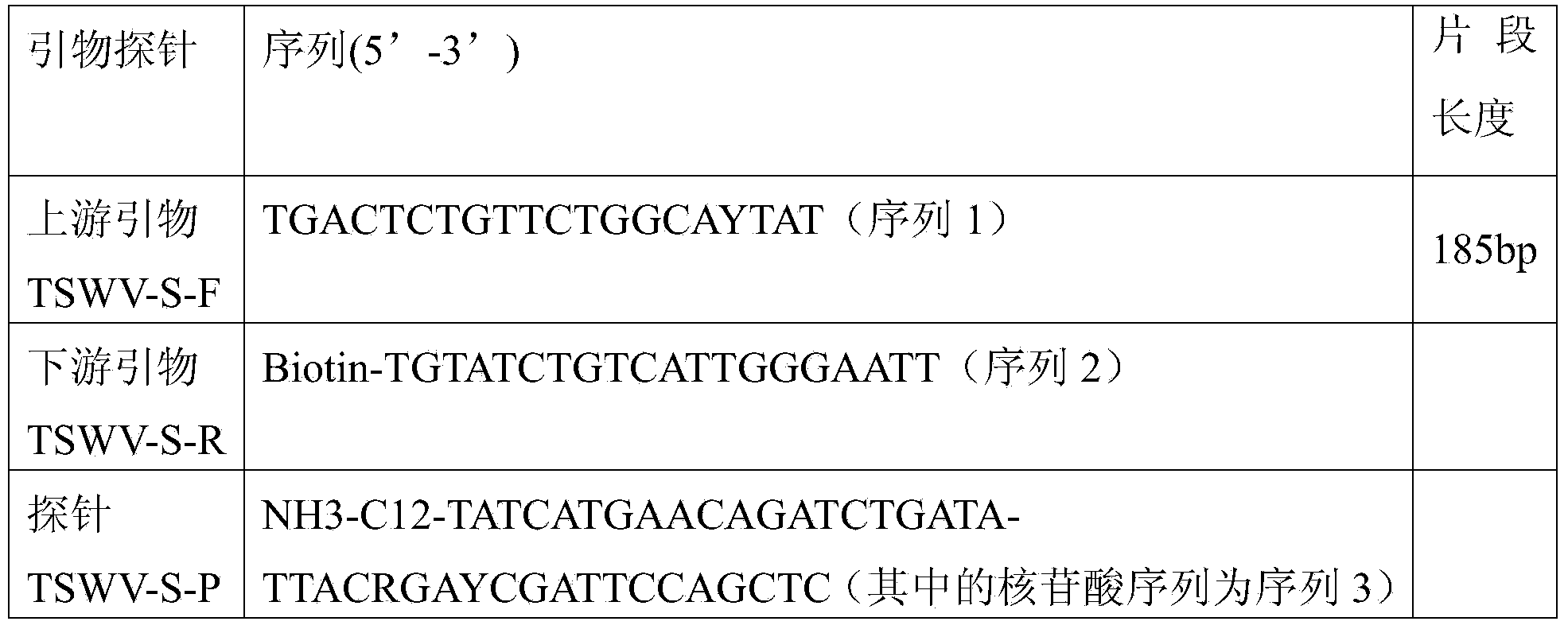Liquid phase chip detection primer of tomato spotted wilt virus, and detection method thereof
A liquid-phase chip detection technology for tomato spotted wilt virus, which is applied in biochemical equipment and methods, microbial measurement/testing, DNA/RNA fragments, etc., to achieve high throughput, good specificity, fast and simple detection methods
- Summary
- Abstract
- Description
- Claims
- Application Information
AI Technical Summary
Problems solved by technology
Method used
Image
Examples
Embodiment 1
[0041] Example 1, Preparation of Tomato Spotted Wilt Virus Liquid Chip Detection Primers, Probes and Kit
[0042]According to the nucleotide sequence of tomato spotted wilt virus reported by NCBI, primers and probes were designed using Primer Premier 5.0 software, and finally a pair of primers and probes with high specificity were screened out and artificially synthesized. The sequences are shown in Table 1 shown.
[0043] Table 1 Designed primers and expected target fragment length
[0044]
[0045] The 5' end of the primer shown in Sequence 2 above was labeled with Biotin.
[0046] After each of the above primers and probes is packaged independently, it can be used as a component of a kit for detecting tomato spotted wilt virus liquid chip.
Embodiment 2
[0047] Example 2, Application of Tomato Spotted Wilt Virus Liquid Chip Detection Primers, Probes and Kits
[0048] 1. Establishment of liquid chip detection method for tomato spotted wilt virus
[0049] 1. Detection of cDNA acquisition of samples
[0050] 1) Extraction of detection sample RNA
[0051] Use Invitrogen's Trizol Reagent (product number: 15596-026) to extract RNA from the sample to be tested, and follow the steps in the instructions.
[0052] 2) cDNA synthesis: Add 1 μL total RNA, 2 μL (10 μmol / L) downstream primer TSWV-S-R (no biotin labeling required), 1 μL dNTP Mix (10 mmol / L) and 10 μL DEPC-H to a 0.2 mL reaction tube 2 O; after mixing, heat at 70°C for 10 min, quickly transfer to ice for 5 min, and centrifuge briefly; then add 5 μL of 5× reverse transcription buffer and 0.5 μL RNase inhibitor (40 U / μL) to the reaction tube, 0.5 μL reverse transcriptase (200 U / μL); gently mix, centrifuge briefly; react at 42°C for 1 hour, quench on ice for 5 minutes, and obt...
Embodiment 3
[0091] Example 3, Primers and detection method for detection of tomato spotted wilt virus liquid chip detection actual sample to be tested
[0092] In order to better verify the practical application effect of the primer probe of the present invention, the present invention uses tomato (Lycopersicon.esculentum) leaves (sample 1) infected with tomato spotted wilt virus and detects with RT-PCR method to determine that it is not infected by tomato spot. Four samples (sample 2, sample 3, sample 4, sample 5) infected with wilt virus were tested at the same time.
[0093] The method is the same as Step 1 in Example 2.
[0094] The results show (Table 4), the test result of the infected sample is positive, and the sample that has not been infected by tomato spotted wilt virus is negative, thereby proving that the method of the present invention can effectively detect whether there is tomato in the sample to be tested. Spotted wilt virus.
[0095] Table 4 liquid chip method detects ...
PUM
 Login to View More
Login to View More Abstract
Description
Claims
Application Information
 Login to View More
Login to View More - Generate Ideas
- Intellectual Property
- Life Sciences
- Materials
- Tech Scout
- Unparalleled Data Quality
- Higher Quality Content
- 60% Fewer Hallucinations
Browse by: Latest US Patents, China's latest patents, Technical Efficacy Thesaurus, Application Domain, Technology Topic, Popular Technical Reports.
© 2025 PatSnap. All rights reserved.Legal|Privacy policy|Modern Slavery Act Transparency Statement|Sitemap|About US| Contact US: help@patsnap.com



